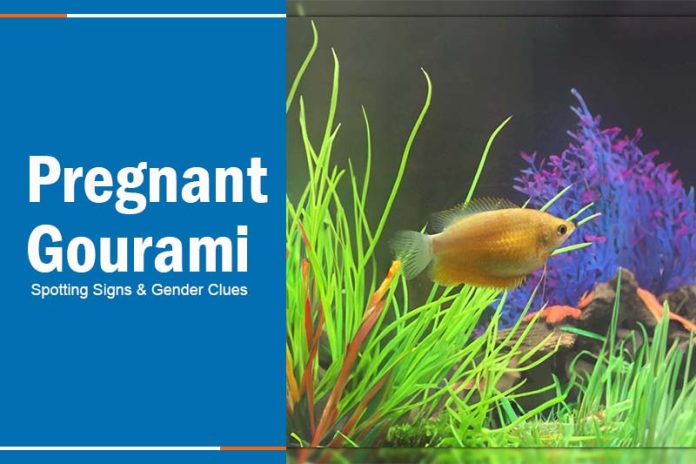Have you recently noticed your gourami displaying a fuller belly or unusual behavior? Are you pondering whether your beloved fish might be expecting some tiny finned additions soon? Understanding the signs of a pregnant gourami can be both intriguing and essential for their care. Dive into our guide to discern the subtle hints and learn everything you need to know about recognizing and caring for a pregnant gourami, including how long does a fish stay pregnant.
Do Gouramis lay Eggs?
All species of Gourami fish are egg layers, and they exhibit a rather fascinating reproductive behavior—bubble nest building. During the breeding process, female dwarf gourami and female honey gourami, among others, craft intricate bubble nests as a secure environment for spawning and nurturing their offspring. To facilitate this remarkable activity, consider adding floating plants or similar buoyant objects to your aquarium. Most Gourami species prefer to attach their delicate bubble nests to these floating elements, offering an ideal setting for both the eggs and the young fry to thrive.
What Do Gourami Eggs Look Like?
Pregnant Gourami lays eggs, of course! Gourami eggs are as unique as the fish themselves, and they come in three primary varieties: adhesive, bubble nest, and free-floating. Understanding these types can offer intriguing insights into the reproductive strategies of these captivating creatures.
Adhesive Eggs: These eggs have a sticky quality that allows them to adhere to surfaces, earning them the term ‘adhesive.’ You might also hear them referred to as ‘glued eggs,’ although this terminology can be a bit misleading. Unlike what the term might suggest, these eggs are naturally adhesive and are not glued to surfaces artificially. It’s worth noting that other fish species might have ‘glued’ eggs that don’t stick to surfaces, adding to the confusion. In the world of pregnant Gourami, adhesive eggs are predominantly laid by females, although males can produce them too.

Bubble Nest Eggs: Picture an egg that resembles something a child might blow through a bubble wand—only with some natural mucous to help it float. These are bubble nest eggs, and they are truly captivating to observe. If you dim your aquarium lights for a few hours, you may catch a glimpse of these bubble-like orbs floating in the water. Typically, you’ll find these eggs in small clusters, numbering between 10 and 20 per group. These eggs are exclusively the handiwork of pregnant Gouramis.
Free-Floating Eggs: Unlike their adhesive and bubble counterparts, free-floating eggs neither stick to surfaces nor float at the top of the water. They are at the mercy of the aquarium currents, drifting freely and often becoming a tempting snack for other fish or shrimp sharing the tank.
Pregnant Gourami: Interesting facts
While the term “pregnant” might not strictly apply to Gouramis, these fascinating fish do exhibit distinct behaviors and physical changes when they are ready to lay eggs. Technically, they’re “gravid” with eggs rather than pregnant Gourami, as the eggs are fertilized externally rather than inside the female’s body.
If you’re wondering how long are pregnant Gourami, it’s essential to remember that gouramis don’t really get “pregnant” in the way mammals do; they become “gravid,” which is a different biological state.
Visual Cues of a Gravid Gourami: Gourami obesity is not common, so if you notice a pregnant Gourami, it’s quite likely that she’s carrying roe (unfertilized eggs). This physical change can be a handy visual cue for hobbyists eager to witness the marvelous process of Gourami reproduction.
How to Know If Your Gourami Fish Is Pregnant?

Determining whether your pregnant Gourami is in a gravid state—carrying eggs ready for fertilization—can be an exciting part of fishkeeping. While Gouramis are not technically “pregnant” as they lay externally fertilized eggs, there are distinct signs that your female Gourami is ready for spawning. Here’s a step-by-step guide to help you recognize these indicators:
Step 1: Observe Behavior Patterns
Pay close attention to both your female and male Gouramis. If you notice them swimming in close proximity, with their bodies touching, this could be a precursor to mating and a sign that the female is entering her gravid phase.
Step 2: Examine Physical Changes
Look for any noticeable swelling in the female pregnant Gourami area, specifically right under her front end. If she’s gravid, her belly will resemble a little pouch, almost as if she’s swallowed a marble. Additionally, you may observe that the scales in this swollen area appear stretched and slightly paler than usual.
Step 3: Search for a Bubble Nest
Gouramis are known for building bubble nests to house and protect their eggs during the embryo development stage. This structure is crafted by the male and usually appears as a mat of bubbles floating on the water’s surface. Spotting a bubble nest in your tank is a strong indicator that your Gouramis are preparing for spawning.
Tips for Dwarf Gourami Care
How To Take Care of Pregnant Pearl Gourami Fish?

Raising a pair of Pearl Gourami ready for spawning can be both rewarding and engaging. Since these fascinating creatures lay eggs instead of bearing live young, it’s crucial to provide an optimal environment for successful breeding. Here’s how to go about it:
- Identify Their Gender
You might not have considered the gender of your Pearl Gourami when you first brought them home, but now it’s time to tell the males from the females. Female Gouramis tend to show a color change around their belly and underside as they prepare for the mating process. - Set Up the Breeding Tank
Prepare a separate breeding tank that can accommodate 10 to 20 gallons of water for each Gourami pair. Maintain the water temperature between 74 to 79 degrees Fahrenheit and keep the pH levels stable between 6.5 to 7.5. To sustain a high-quality water environment, undertake regular water changes, ideally 10 to 25 percent on a weekly basis. - Introduce the Female to the Breeding Tank
Release the female Gourami into the breeding tank first. To ease her transition, use a plastic bag filled with water from the main tank, and then gradually add water from the breeding tank. This allows her to acclimate to the new conditions before you release her into her temporary new home. - Nutritional Needs of the Breeding Pair
Both the male and female pregnant Gourami will need a nutritionally enriched diet for successful breeding. Your options include a mix of live and frozen foods like:
- Blood worms
- Mosquito larvae
- Brine shrimp
- Monitor and Remove the Female After Spawning
Breeding Gouramis often takes a few days, so keep a close eye on them. Once the male has constructed the bubble nest and you observe spawning activities, it’s time to remove the female from the tank.
Read more: Dwarf Gourami Tank Mates
How to Tell if a Male or Female Gourami?

Entering the world of fishkeeping, you’ll quickly discover that each species has its own unique set of characteristics. Among these is the Gourami, a popular choice for many aquarium enthusiasts. If you’ve found yourself wondering about the gender of your Gourami, you’re not alone. Distinguishing between male and female Gouramis can be both fascinating and important for various reasons, including breeding or tank harmony.
Size and Shape: Male Gouramis often appear a tad smaller than their female counterparts. They possess a sleeker and slimmer physique, whereas females tend to have a more rounded belly. This roundness can especially be noticed when looking at the fish from the side.
The Dorsal Fin – A Key Identifier: While size and body shape offer some clues, the most pronounced difference lies in the dorsal (top) fin. Observing this fin can be a clear giveaway when trying to identify the gender of your Gourami.
Honey Gourami Laying Eggs
Conclusion
In conclusion, recognizing a pregnant gourami and understanding their specific needs can greatly enhance your fishkeeping journey. Armed with the knowledge from our guide, you’re now well-equipped to ensure the health and happiness of your gouramis during this special phase.
For more expert insights and tips on aquarium life, be sure to explore other blogs from Kalonaquatics. We’re here to help every step of the way in your aquatic adventures!
Learn more:
- Why Is My Gourami Laying on the Bottom of the Tank?
- Dwarf Gourami Tank Size: Expert Tips for a Thriving Aquarium

Growing up in a coastal town, surrounded by the soothing sounds of ocean waves, I have developed an early fascination with marine life. This fascination eventually led me to a career as an aquatic biologist and a passion for sharing my knowledge with the world. With years of experience, I’m here to help you create vibrant and sustainable underwater ecosystems. Swim along with me on this fin-tastic journey!

